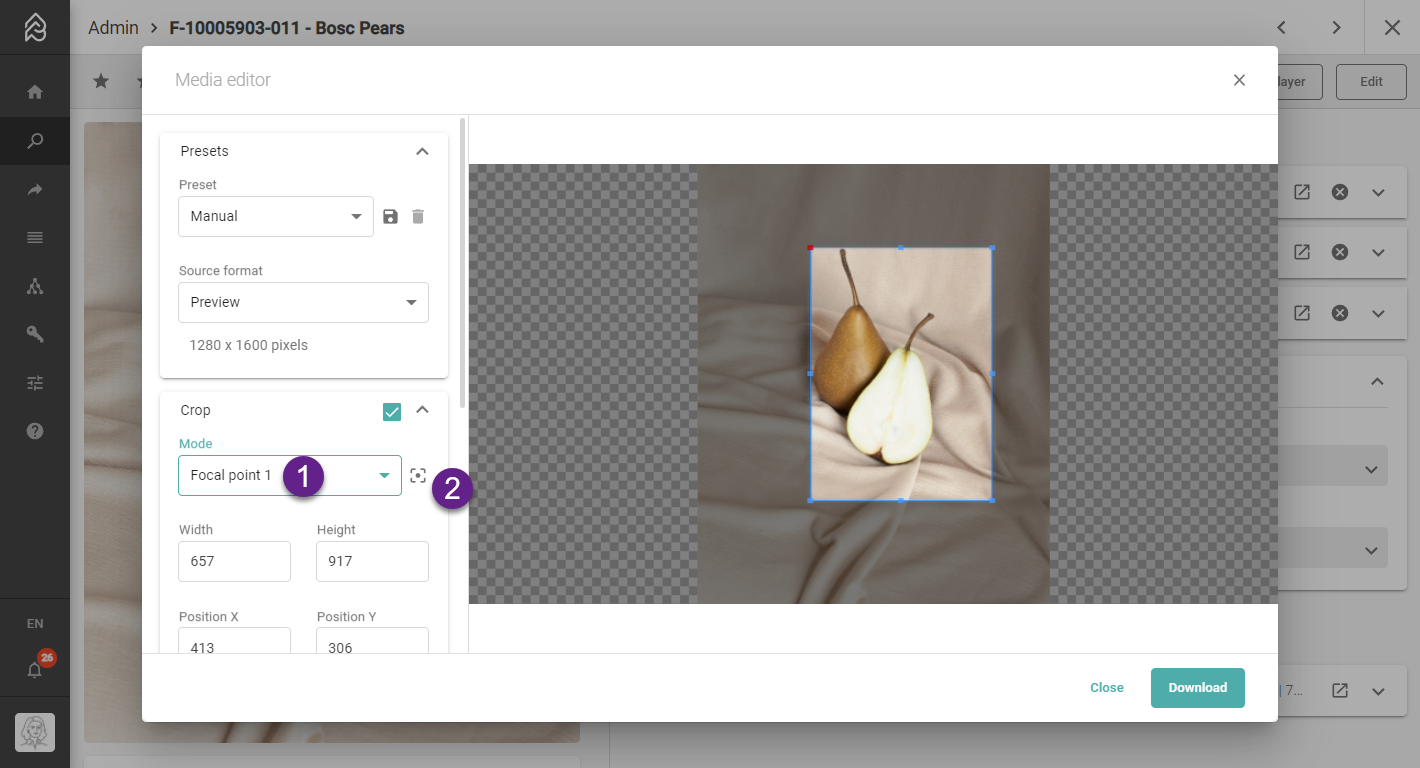Downloads
You can download every content item from Picturepark to your local desktop if you like. You can download file-based content items in the desired output format, e.g., suitable for website or social media usage. Those are pre-configured for the system. Picturepark exports file-less content items as JSON.
Picturepark generates (renders) static (preconfigured, pre-rendered) and dynamic (on-demand rendered) formats. Both are available in the format selection dialogue which opens up when you download or share.
Dynamic Formats
Dynamic Formats can be defined for images only and are rendered on demand for the selected Content Item in Picturepark and not saved to the storage but only to a cache for the configured retention time. Dynamic formats may be Hero Images, Social Media Images, or Campaign Specials.
The benefits of dynamic rendering
Those are customizable by the customer during operation (setup via API)
Dynamic formats are cached (retention time configuration), so the downloader does not have to wait for frequently accessed content.
Picturepark does not store them on storage which saves money for the monthly storage subscription price.
The drawback of dynamic rendering
The download of multiple dynamic formats of the same Content Item is possible.
Rendering on request (lazy) may take some time until Picturepark generates the output. Picturepark will notify you when you can access the ready-to-download file.
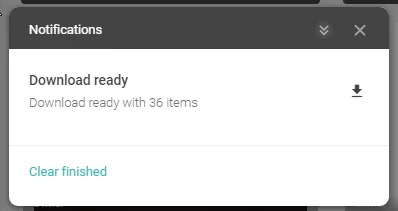
You can continue working in Picturepark while waiting for your download to be ready.
Only available to produce images (rasterized files).
Costs performance of rendering microservice.
Static Formats
Static formats are created on customer creation, predefined, and rendered for every Content Item in Picturepark, saved to the storage. The benefits of static formats
No waiting times for downloading them. Picturepark creates the format after import and every user can then directly download it.
You can have static formats created for all file types (based on rendering support).
The drawback of static formats
Costs storage, as all formats are rendered and saved on the storage.
Previews
Previews are static formats, available for File Types.
The standard windows server fonts are installed on our rendering server and will be applied and rendered to document previews. Any other fonts will be substituted.
You see a file format icon when Picturepark couldn’t render a preview e.g. Indd for Indesign files.
The original file is also available - accessing (download) the Original File can be restricted with Content Permissions.
You cannot restrict Access/Download of previews, but it is possible that you add a watermark to Preview which is then also applied to other Formats and Thumbnails derived from the Preview. Check for formats and thumbnails if their rendering source is the Preview format to ensure that the Watermark is applied everywhere.
Picturepark generates the following previews for supported file formats.
Preview name | Size (max) | Color profile | File Format | Quality | Notes |
Preview | 1600x1600 | SRGB | .jpg | 95 |
|
Thumbnail Large | 320x320 | Original | .jpg | 95 | |
Thumbnail Medium | 200x220 | Original | .jpg | 95 | |
Thumbnail Small | 90x120 | Original | .jpg | 95 | |
Video Keyframes (these are Small thumbnails used in UI for Video Thumb-Slider in player) | 160x160 (max 50 sprites) | RGB | .jpg | 80 | |
(These PDFs are used for display in the document viewer (even though a pdf would have an original it may be too large to make a good document viewer pdf i.e. to display on mobile so we render a format for this.) | NA | 90 | |||
Video Small | 360x480 | .mp4 | |||
Video Large | 1280x720 | .mp4 | |||
Audio Small | NA | .mp3 |
Create a Download Format / Output Format
The static formats are created on customer creation. Check Format Modifications for your desired settings.
The dynamic formats are created via API: https://demo.picturepark.com/Docs/Rest/index.html#operation/OutputFormat_Create . It is recommended to test your settings using the preview operation, which allows generating a temporary preview of your desired output to validate your settings: https://demo.picturepark.com/Docs/Rest/index.html#operation/OutputFormat_RenderFormatPreview based on the actual Content Items of your Picturepark.
Examples
- Output Format: Create Transparent Format for Download
Goal: Output a png with red background.
- Output Format: Watermark Format for Download
Goal: Have a dynamic format with a watermark, created via Postman via API.
- Output Format: Watermark Placement
Goal: Assume you want to place a horizontal colored bar at the bottom of a format with 10px distance to the bottom border and have the logo placed within this colored bar in the right corner with a 10px distance to the right border.
Update a Download Format / Output Format
You cannot update static format attributes (e.g. resizing). You can however update attributes like:
XMP Writeback (enableXmpWriteback; boolean)
Filename pattern used when the file is downloaded (downloadFileNamePatterns; string translated)
Permission to access output formats even if the source is not accessible (viewForAll; boolean)
You can update output formats using the API: https://demo.picturepark.com/Docs/Rest/index.html#operation/OutputFormat_Update
Apply Resize Action
PUT: {{apiHost}}/v1/outputformats/{id}
{
"id": "MyFirstFormat",
"names": {
"en": "My first format"
},
"sourceOutputFormats": {
"image": "Original",
"video": "VideoPreview",
"document": "DocumentPreview",
"audio": "AudioPreview",
"vector": "VectorPreview"
},
"format": {
"kind": "JpegFormat",
"resizeAction":{
"width":50,
"height":50,
"resizeMode":"fit"
}
}
}Media Optimization (IO)
Media Optimization (IO) enables you to crop, resize, sharpen, change transparency or rename images using the media editor, requiring permission to edit images (role permission). The images can then be integrated into websites, e-commerce stores, or other apps. Content Delivery Networks (CDN) further improve global delivery and availability.
If you are using Picturepark Premium or Enterprise plans, the Media Optimisation features used for creating tailored embed links and/or converting media files are fully available. For Starter plans, only embeds based on static or dynamic formats can be used without applying dynamic conversion parameters, for which the Image Optimisation Add-on can be purchased as an option.
The Fastly CDN Connector might be mandated for high-load use cases and a basic usage quota is already included in the corresponding Plans or Add-ons. Additional restrictions apply for media file conversions - please see the Subscription Plan FAQ for more information.
Media Editor
The media editor lets you dynamically make advanced transformations and image optimizations without changing the original. You can see the results instantly in the preview on the right. You can execute various modifications and validate your results by enabling or disabling them, and you can also chain everything together for multi-layered optimizations.
The following rendering actions are available:
Crop, resize, rotate, sharpen.
Alpha channel transparency (replace).
Conversion into JPG, PNG, or TIFF.
Rename the default filename for SEO purposes.
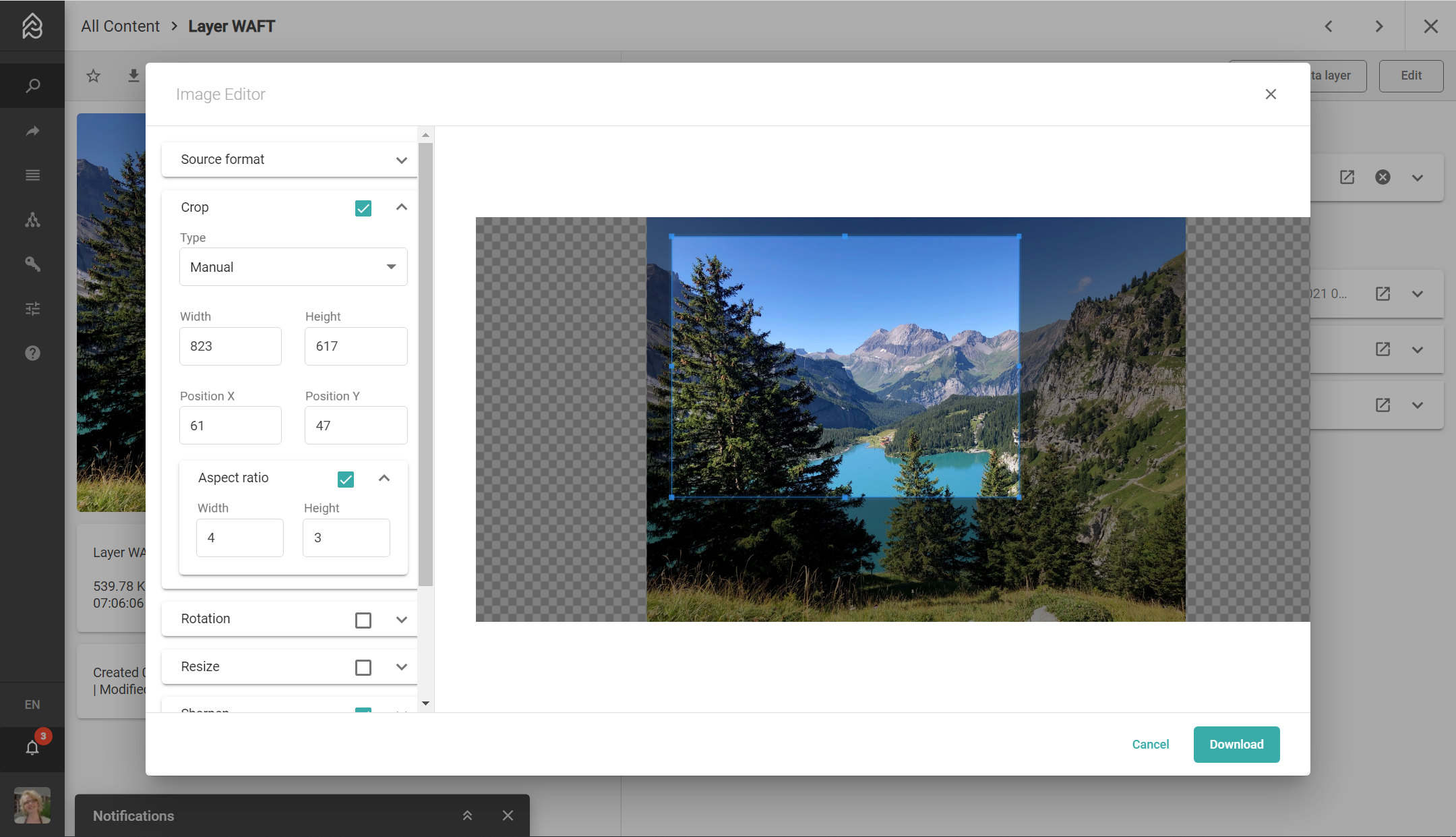
Cropping Images in Picturepark for Commerce Integrations
Conversion presets
Editors can save their settings defined in the Media Editor as content presets for later re-use for the same image.
Additionally, editors can create conversion preset templates in settings to make them available for any image, requiring the role permission to “manage conversion preset templates”.
The conversion preset template itself has no permission.
A conversion preset template requires:
Name: the name that appears in the Media editor
Description: for internal purposes, not shown anywhere
Template: the conversion string (with the option to add a placeholder for a focal point)
Output format: the source where the conversion settings are applied
When you select a content preset and add modifications, you can save (overwrite) or save it as a new content preset.
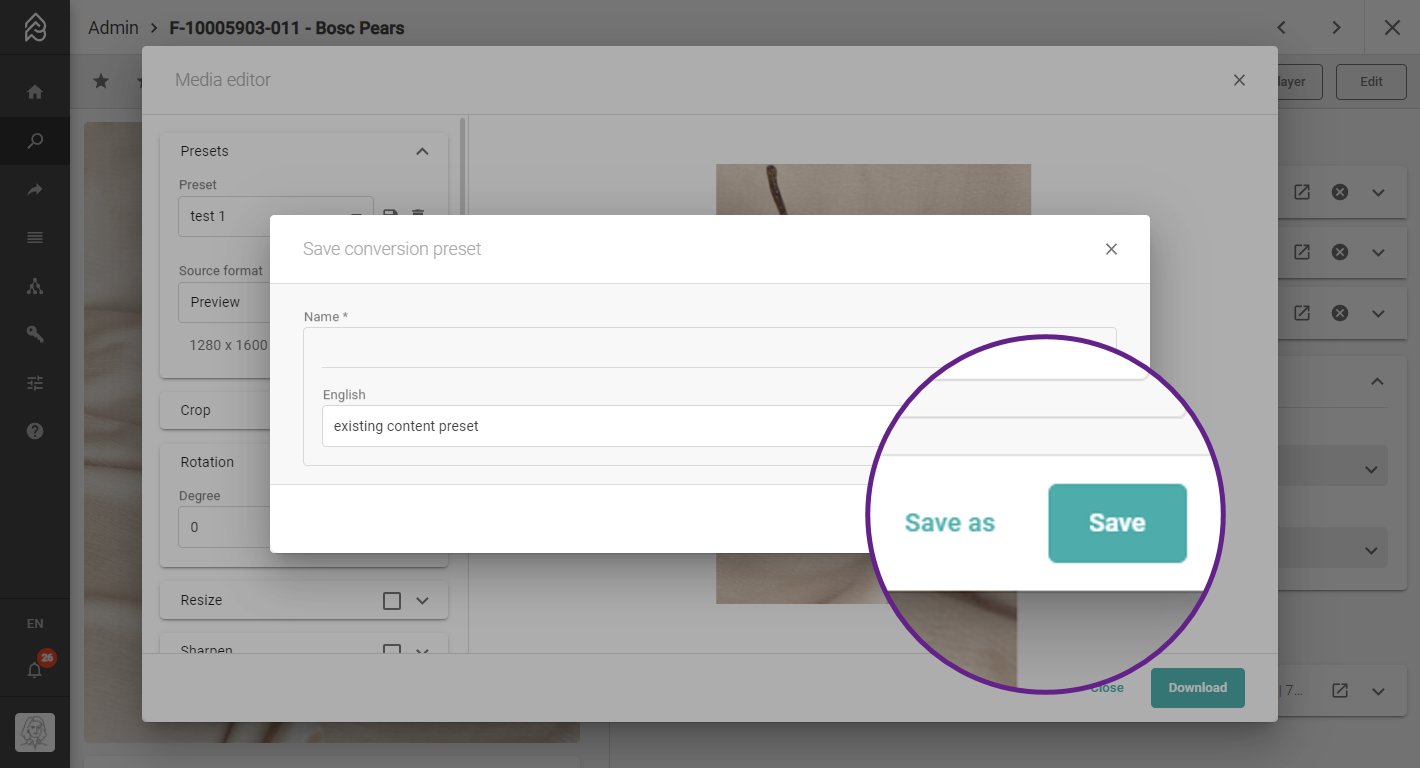
Common conversion preset templates are in use for
Website hero or header images.
Product shots used in commerce stores.
Detail extracts from large-scale images.
Different social media channels.
Placeholders in sales presentations.
Permissions
If you want to enable your users to create and update conversion presets, the user's role must have “manage items” permissions on the layer “Image Analytics.”
Focal Point Editor
The focal point editor for images enables users to create, update, or remove focal points, including those created by an AI provider such as Clarifai or Azure. Permitted users can either create single focal points or bounding boxes that surround an object, such as a face.
Click on the image to create a focal point, and click and hold to create a bounding box.
The focal point editor in Picturepark.
Each focal point has:
Identifier: the short name of your focal point
Confidence level: a number between 0 and 1, whereas 1 is 100% confidence.
Optional reference: additional text which serves as a description.
The bounding box also had width and height fields.
All information will be saved into the Image Analytics Layer of the image.
Cropping around Focal Points
For every Content Item, you can create focal points in the Focal Point Editor or via cropping to focal points from within the Media Editor. Additionally, AI Tagging proposes focal points for available areas of interest within an image. Depending on the model you choose, AI can also propose brand names, text, or demographics.
All focal points are saved to the layer “Image Analytics”, from which you can pick the ones to apply as a cropped onto your images in the Media Editor.
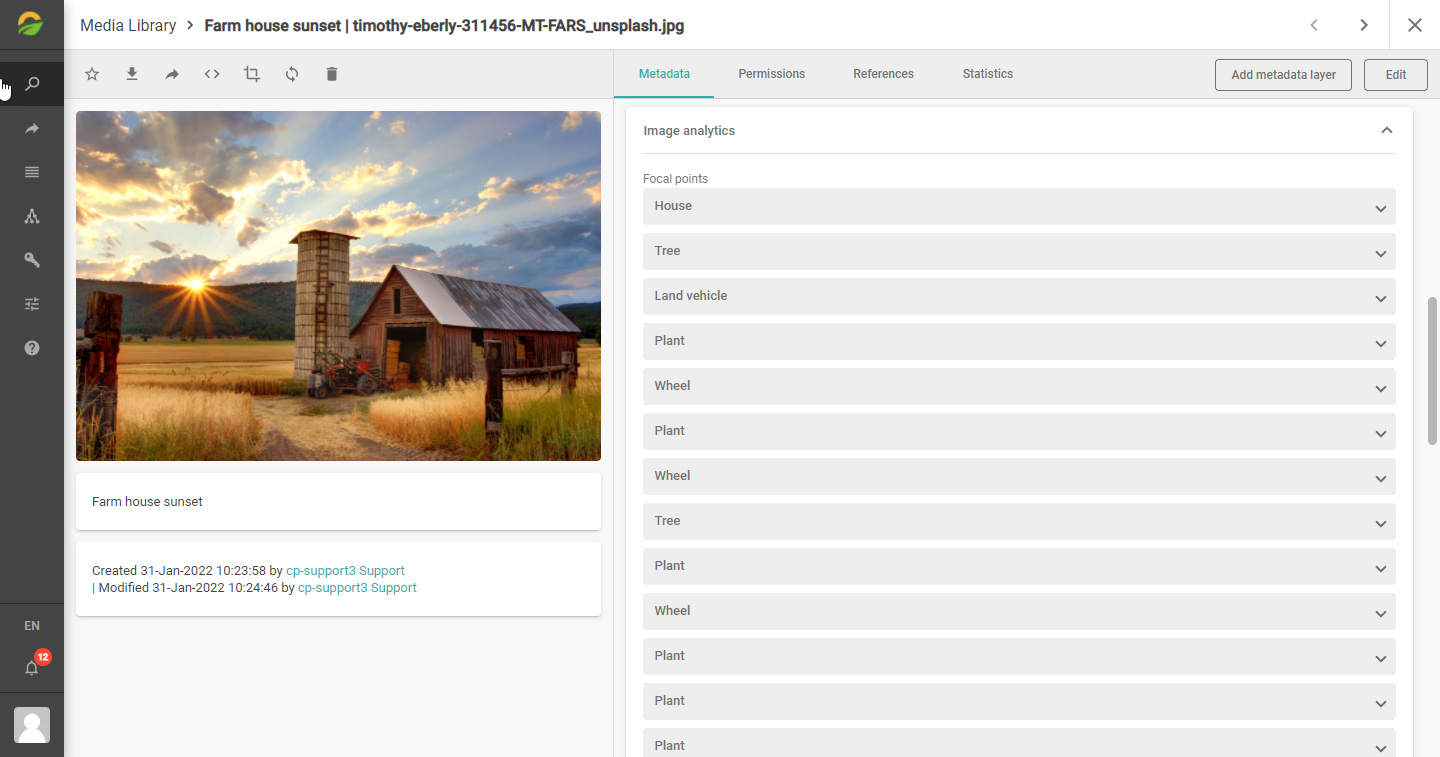
You can create (2) or select existing focal points (1) for cropping in the Media Editor.
